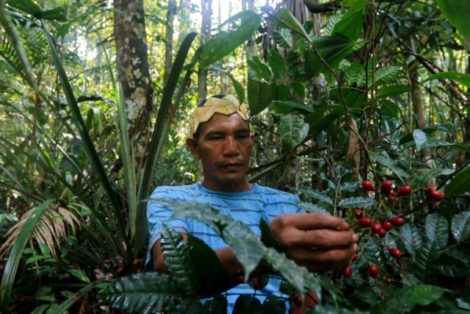
Valdiney Satere, a leader of the Satere Mawe indigenous tribe, gathers caferana, a plant used in medicinal remedies in Brazil’s Amazon region. Image: Ricardo Oliveira/AFP
Far from lab coat and face mask territory, a group of indigenous healers with feather and leaf headdresses is working its way up the Amazon river, looking for medicinal plants to treat the new coronavirus.
In a small motorboat, five men from the Satere Mawe tribe are trying to help their people survive without using the saturated state health system in Amazonas, in northwestern Brazil, which despite its remoteness is one of the places hit hardest by the pandemic.
Satere Mawe healers return to their community in Brazil’s Amazonas state, after collecting herbs to be used in treatments for symptoms of COVID-19. Image: Ricardo Oliveira/AFP
“We’ve been treating our symptoms with our own traditional remedies, the way our ancestors taught us,” said Andre Satere Mawe, a tribal leader who comes from a small village on the far outskirts of the state capital, Manaus.
“We’ve each used the knowledge handed down to us to gather treatments and test them, using each one against a different symptom of the disease.”
The rapid spread of the virus in Amazonas, where more than 20,000 people have been infected and 1,400 have died, has overwhelmed hospitals and forced authorities to dig mass graves for the dead.
It has also raised fears for the region’s indigenous peoples, who have a tragic history of being decimated by diseases brought in from the outside world.
The virus has infected 40 indigenous groups, with 537 positive cases and 102 deaths, according to the Brazilian Indigenous Peoples’ Association.
‘Fending for ourselves’
The Satere Mawes’ remedies include teas made from the bark of the carapanauba tree, which has anti-inflammatory properties; from the saracuramira tree, an anti-malarial; and ingredients such as mango peel, mint and honey.
Villagers who suspect they have had the new coronavirus say the traditional remedies work.
“I was feeling weak, it felt like I had something in my lungs, I couldn’t breathe,” said Valda Ferreira de Souza, a 35-year-old artisan.
“I took a home-made syrup, which made me feel a lot better.”
Rosivane Pereira da Silva, 40, helps Andre Satere Mawe prepare these remedies. She learned the techniques from her grandfather Marcos, who at 93 years old is still teaching her what he knows.
When the pandemic arrived in Amazonas, “I went and asked him what to do,” said Da Silva.
The Satere Mawe, an ethnic group of about 13,000 people, live mainly in the Andira-Marau indigenous reserve.
A child from Brazil’s satere mawe indigenous community sits next to a man preparing medicinal herbs to treat coronavirus infections. Image: Ricardo Oliveira/AFP
But Andre Satere Mawe’s group and others have moved closer to Manaus in recent decades.
Not that they are relying on the city’s health services.
“They’ve been forced to choose who gets care and who doesn’t — and we don’t,” he said.
“But we’ve learned to fend for ourselves.” NVG
RELATED STORIES:
Indigenous infections grew amid slow Brazil agency response
Coronavirus curfew complicates lives of Kuwaiti polygamists